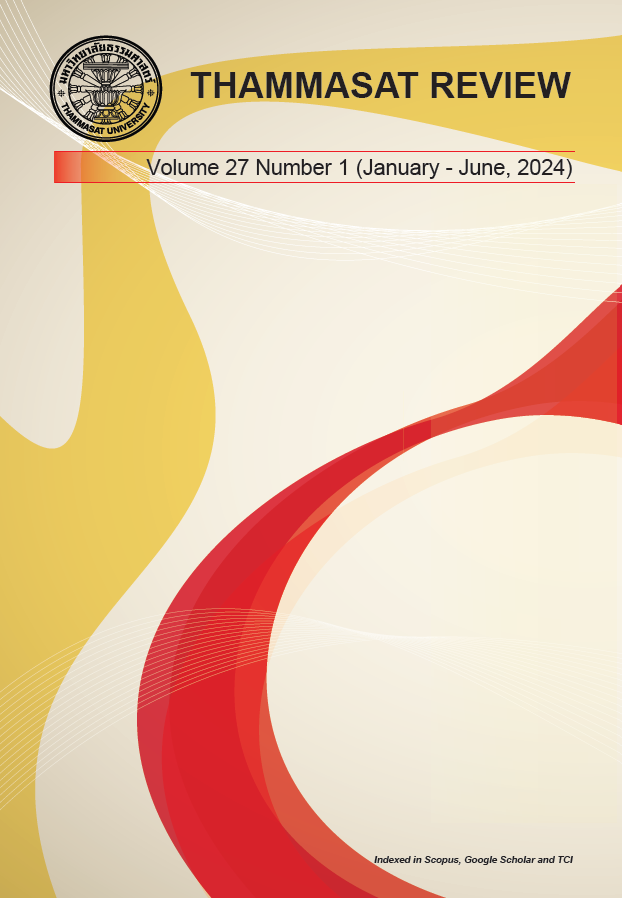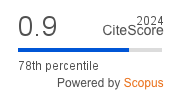Health System Capacities and Policy Responses to a Global Health Crisis: A Comparative Study Between Thailand and China
Keywords:
Health System, Governance, COVID-19, Thailand, ChinaAbstract
The governance and sustainability of health systems are essential for human well-being, particularly during public health crises like COVID-19. Despite achieving low fatality rates and high vaccination levels, Thailand and China have adopted both similar and distinct policy responses to the pandemic. This study conducts a qualitative analysis based on documentary research to examine the policy responses of both countries and the underlying rationale. The analysis is framed by the six building blocks of health system strengthening as proposed by the World Health Organization (WHO). It also incorporates an examination of health system responses and governance capacities during public health crises to evaluate the policy decisions of both nations. The findings reveal that the policy responses of Thailand and China are influenced by the respective strengths of their health systems and governmental capacities. Both countries adhered to WHO operational guidelines for combating COVID-19; however, China implemented these measures more rigorously. Thailand, characterized by a robust health system but limited governance capacity, adopted a "Coexistence with COVID-19" policy, reopening the country once vaccines became available. Conversely, China's relatively weaker and fragmented health system necessitated a stringent "Zero-COVID" policy, heavily relying on its governance capacity to manage the pandemic. Therefore, governance capacity, alongside health system strength and responsiveness, is critical in determining policy responses during public health crises.
References
Bhattacharyya, O., Delu, Y., Wong, S. T., & Bowen, C. (2011). Evolution of primary care in China 1997-2009. Health Policy, 100(2-3), 174-180. https://doi.org/10.1016/j.healthpol.2010.11.005
Brixi, H., Mu, Y., Targa, B., & Hipgrave, D. (2011). Equity and public governance in health system reform: challenges and opportunities for China. The World Bank.
Bureau of Information, Ministry of Public Health (2022). The Ministry of Public Health is ready to transfer 3,264 Subdistrict Health Promoting Hospitals according to the Cabinet resolution, setting up a working group to closely monitor, confirmed that it will not affect the care delivered to the people. https://pr.moph.go.th/print.php?url=pr/print/2/04/179131/
Central Intelligence Agency. (2023). The World Factbook. https://www.cia.gov/the-world-factbook/field/maternal-mortality-ratio/country-comparison/
Cheng, Y., Yu, J., Shen, Y., & Huang, B. (2020). Coproducing responses to COVID‐19 with community‐based organizations: lessons from Zhejiang province, China. Public Administration Review, 80(5), 866-873.
Department of Disease Control. Ministry of Public Health (2020). Coronavirs disease (COVID-19). https://ddc.moph.go.th/viralpneumonia/index.php
Department of Disease control, Ministry of Public Health (2023). Report on progress of COVID-19 vaccination services. https://ddc.moph.go.th/vaccine-covid19/pages/รายงานความก้าวหน้าการให้บริการฉีดวัคซีนโควิด-19
Eggleston, K., Ling, L., Qingyue, M., Lindelow, M., & Wagstaff, A. (2008). Health service delivery in China: a literature review. Health Econ, 17(2), 149-165. https://doi.org/10.1002/hec.1306
Fang, H., Eggleston, K., Hanson, K., & Wu, M. (2019). Enhancing financial protection under China’s social health insurance to achieve universal health coverage. bmj, 365.
Jiang, Y., & Yu, J. (2020). The employment of policy tools in the management of major public health crisis: the content- An analysis based on the COVID-19 prevention and control policy of the central government. Journal of Public Management, 17(4), 1-9,163.
Lee, P. (2022). Timeline: Key dates in China’s ‘blank placard’ zero-Covid protests. Hong Kong Free Press.
Li, X., Lu, J., Hu, S., Cheng, K. K., De Maeseneer, J., Meng, Q., Mossialos, E., Xu, D. R., Yip, W., Zhang, H., Krumholz, H. M., Jiang, L., & Hu, S. (2017). The primary health-care system in China. The Lancet, 390(10112), 2584-2594. https://doi.org/10.1016/s0140-6736(17)33109-4
Liu, Y., & Saltman, R. B. (2020). Policy lessons from early reactions to the COVID-19 virus in China. American Journal of Public Health, 110(8), 1145-1148.
Ma, S., Lawpoolsri, S., Soonthornworasiri, N., Khamsiriwatchara, A., Jandee, K., Taweeseneepitch, K., Pawarana, R., Jaiklaew, S., Kijsanayotin, B., & Kaewkungwal, J. (2016). Effectiveness of implementation of electronic malaria information system as the national malaria surveillance system in Thailand. JMIR public health and surveillance, 2(1), e5347.
Mei, C. (2020). Policy style, consistency and the effectiveness of the policy mix in China’s fight against COVID-19. Policy and Society, 39(3), 309-325.
Ministry of Public Health. (2023). HDC. https://hdcservice.moph.go.th/hdc/main/index.php
Narkvichien, M. (2020). Thailand' 1 million village health volunteers unsung heroes are helping guard communities nationwide from COVID-19. https://www.who.int/thailand/news/feature-stories/detail/thailands-1-million-village-health-volunteers-unsung-heroes-are-helping-guard-communities-nationwide-from-covid-19
National Bureau of Statistics. (2023). National Data. https://data.stats.gov.cn/easyquery.htm?cn=C01
National Health Security Office. (2018). Annual Report of National Health Security Office for the 2017 Fiscal Year. Bangkok
National Healthcare Security Administration. (2023). 2022 National Medical Security Development Statistical Bulletin. http://www.nhsa.gov.cn/art/2023/7/10/art_7_10995.html
Nuclear Threat Initiative, Johns Hopkins Center for Health Security, & Economist Intelligence Unit. (2021). Global Health Security Index. https://www.ghsindex.org
OECD. (2023). OECD data. https://data.oecd.org
Patcharanarumol, W., Panichkriangkrai, W., Wangmo, S., Thammatacharee, J., Uechi, M., & Wanwong, Y. (2016). Diabetes prevention and care in the universal health coverage context: the example of Thailand. WHO South-East Asia journal of public health, 5(1), 27.
Polwiang, S. (2023). The lockdown and vaccination distribution in Thailand's COVID-19 epidemic: A model study. Infectious Disease Modelling.
Prakongsai, P., Limwattananon, S., & Tangcharoensathien, V. (2009). The equity impact of the universal coverage policy: Lessons from Thailand Advances in health economics and health services research 21. https://doi.org/10.1108/s0731-2199(2009)0000021006
Primary Health Care Division, D. o. H. S. S. (2014). The Four-Decade Development of Primary Health Care in Thailand (1978-2014) Nonthaburi: The War Veterans Organization of Thailand Under Royal Patronage of His Majesty The King
Rakmawati, T., Hinchcliff, R., & Pardosi, J. F. (2019). District-level impacts of health system decentralization in Indonesia: A systematic review. Int J Health Plann Manage, 34(2), e1026-e1053. https://doi.org/10.1002/hpm.2768
Ramesh, M., Wu, X., & He, A. J. (2014). Health governance and healthcare reforms in China. Health Policy Plan, 29(6), 663-672. https://doi.org/10.1093/heapol/czs109
Saechang, O. (2021). The Impact of Health System Reform on the Governance and Performance of Primary Health Care System in Thailand Zhejiang University].
Saechang, O., Yu, J., & Li, Y. (2021). Public trust and policy compliance during the COVID-19 pandemic: The role of professional trust. Healthcare (Vol. 9, No. 2, p. 151).
Shambaugh, David L. 2008. China's communist party: atrophy and adaptation. Univ of California Press.
Shi, Z., He, P., Zhu, D., Lu, F., & Meng, Q. (2022). Changes in health care utilization and financial protection after integration of the rural and urban social health insurance schemes in Beijing, China. BMC Health Services Research, 22(1), 1-14.
Somkotra, T., & Lagrada, L. P. (2008). Payments for health care and its effect on catastrophe and impoverishment: experience from the transition to Universal Coverage in Thailand. Social Science & Medicine, 67(12), 2027-2035.
Strategy and Planning Division, Ministry of Public Health. (2019). Geographic information system of health resources. http://gishealth.moph.go.th/healthmap/gmap.php
Sumriddetchkajorn, K., Shimazaki, K., Ono, T., Kusaba, T., Sato, K., & Kobayashi, N. (2019). Universal health coverage and primary care, Thailand. Bull World Health Organ, 97(6), 415-422. https://doi.org/10.2471/BLT.18.223693
Tangcharoensathien, V., Prakongsai, P., Limwattananon, S., Patcharanarumol, W., & Jongudomsuk, P. (2007). Achieving Universal Coverage in Thailand: What Lessons Do We Learn? . https://www.who.int/social_determinants/resources/csdh_media/universal_coverage_thailand_2007_en.pdf
Tangcharoensathien, V., Tisayaticom, K., Suphanchaimat, R., Vongmongkol, V., Viriyathorn, S., & Limwattananon, S. (2020). Financial Risk Protection of Thailand Universal Health Coverage: results from series of national household surveys between 1996 and 2015. Int J Equity Health. https://doi.org/https://doi.org/10.1186/s12939-020-01273-6
Tangcharoensathien, V., Witthayapipopsakul, W., Panichkriangkrai, W., Patcharanarumol, W., & Mills, A. (2018). Health systems development in Thailand: a solid platform for successful implementation of universal health coverage. The Lancet, 391(10126), 1205-1223. https://doi.org/10.1016/s0140-6736(18)30198-3
United Nations. (2023). 17 Goals. https://sdgs.un.org/goals
Wagstaff, A., Yip, W., Lindelow, M., & Hsiao, W. C. (2009). China's health system and its reform: a review of recent studies. Health Econ, 18 Suppl 2, S7-23. https://doi.org/10.1002/hec.1518
Wang, L., Wang, Z., Ma, Q., Fang, G., & Yang, J. (2019). The development and reform of public health in China from 1949 to 2019. Globalization and health, 15, 1-21.
Wasi, P. (2000). "Triangle that moves the mountain" and health systems reform movement in Thailand. Human Resources for Health Development Journal, 4, 106-110.
Weiyuan, C. (2008). China's village doctors take great strides. In: World Health Organization.
World Bank. (2023). World Bank Open Data. https://data.worldbank.org
World Health Organization. (2007). Everybody's business--strengthening health systems to improve health outcomes: WHO's framework for action.
World Health Organization. (2017). Primary health care systems (PRIMASYS): Case study from Thailand. In (Vol. abridged version). Geneva.
World Health Organization. (2021). COVID-19 Strategic preparedness and response plan.
World Health Organization. (2023a). Country readiness for COVID-19 vaccines. https://www.who.int/news-room/feature-stories/detail/country-readiness-for-covid-19-vaccines
World Health Organization. (2023b). Universal health coverage (UHC). https://www.who.int/news-room/fact-sheets/detail/universal-health-coverage-(uhc)
World Health Organization. (2023c). WHO Coronavirus (COVID-19) Dashboard. https://covid19.who.int
Yip, W., Fu, H., Chen, A. T., Zhai, T., Jian, W., Xu, R., Pan, J., Hu, M., Zhou, Z., Chen, Q., Mao, W., Sun, Q., & Chen, W. (2019). 10 years of health-care reform in China: progress and gaps in Universal Health Coverage. The Lancet, 394(10204), 1192-1204. https://doi.org/10.1016/s0140-6736(19)32136-1
Yip, W., & Hsiao, W. (2014). Harnessing the privatisation of China's fragmented health-care delivery. The Lancet, 384(9945), 805-818. https://doi.org/10.1016/s0140-6736(14)61120-x
Yip, W. C.-M., Hsiao, W., Meng, Q., Chen, W., & Sun, X. (2010). Realignment of incentives for health-care providers in China. The Lancet, 375(9720), 1120-1130.
Yip, W. C.-M., Hsiao, W. C., Chen, W., Hu, S., Ma, J., & Maynard, A. (2012). Early appraisal of China's huge and complex health-care reforms. The Lancet, 379(9818), 833-842. https://doi.org/10.1016/s0140-6736(11)61880-1
Yu, H. (2015). Universal health insurance coverage for 1.3 billion people: what accounts for China's success? Health Policy, 119(9), 1145-1152.
Zhang, X., Wen, D., Liang, J., & Lei, J. (2017). How the public uses social media wechat to obtain health information in china: a survey study. BMC medical informatics and decision making, 17, 71-79.
Zheng, W., Yan, X., Zhao, Z., Yang, J., & Yu, H. (2021). COVID-19 vaccination program in the mainland of China: a subnational descriptive analysis on target population size and current progress. Infectious diseases of poverty, 10(1), 1-10.
Downloads
Published
How to Cite
Issue
Section
License
Copyright (c) 2024 Thammasat Review

This work is licensed under a Creative Commons Attribution-NonCommercial-NoDerivatives 4.0 International License.
The opinions and ideas expressed in all submissions published in Thammasat Review are solely that of the author(s) and do not necessarily reflect that of the editors or the editorial board.
The copyright of all articles including all written content and illustrations belong to Thammasat Review. Any individuals or organisation wishing to publish, reproduce and distribute a particular manuscript must seek permission from the journal first.








